Happy 100th Birthday Julia and a recipe for Reine de Saba (Chocolate and Almond Cake)
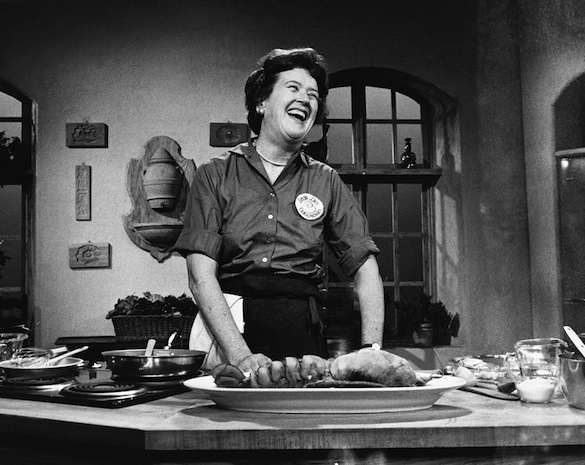
I don’t think about whether people will remember me or not. I’ve been an okay person. I’ve learned a lot. I’ve taught people a thing or two. That’s what’s important. Sooner or later the public will forget you, the memory of you will fade. What’s important are the individuals you’ve influenced along the way. – Julia Child
This is a celebration of what would be Julia Child’s 100th birthday as shared through the recollections and intimate stories of a few of her close friends and several members of Les Dames d’Escoffier International, of which Julia Child was a member. Les Dames d’Escoffier (LDEI) is a culinary organization that has helped transform the role of women in the culinary arts. I have also asked Melanie Young, current President of Les Dames d’Escoffier New York (LDNY) to share her thoughts on the future of LDEI in this evolving culinary world.
It has been many years since Julia Child awakened our culinary senses with her book Mastering the Art of French Cooking and her television show The French Chef. To think that Julia’s first lunch in France with her husband Paul could alter the course of America’s relationship with food and cooking is dramatic. Oysters on the half-shell, Sole Meunière, salad after the meal and all served with a bottle of Pouilly-Fumé. Not all that unusual in France, but that meal was life changing for Julia Child and for so many of us who have been inspired by her. I would not be sitting here writing about Julia’s 100th birthday if she had not had such a great influence on my own life.
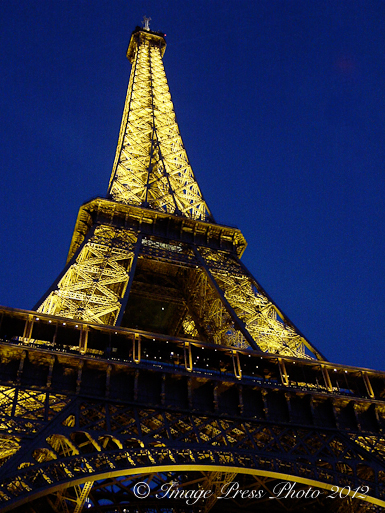
Paris, one of the most romantic cities in the world
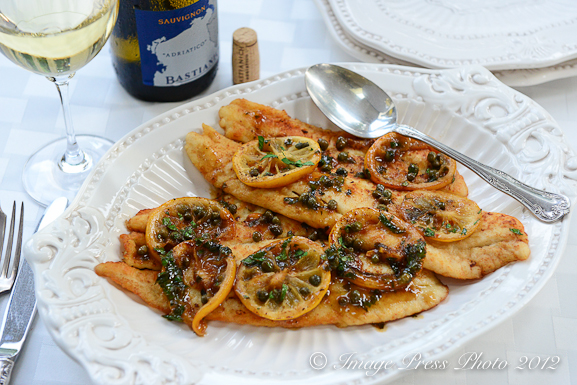
Sole Meunière. Julia’s first meal in France.
Contributing to this article, in addition to Melanie Young are: Carol Brock, the founder of Les Dames d’Escoffier International (LDEI), Dorie Greenspan (member LDNY and author of Baking with Julia and Around My French Table), and Margaret Happel Perry (Chair of the LDNY Scholarship committee). I also spoke with Nancy Verde Barr who was executive chef to Julia Child for eight years (1990 – 1998). In addition, she is the author of Backstage with Julia: My Years with Julia Child and was the culinary producer for PBS’s Baking with Julia and ABC’s Good Morning America. These women have graciously shared their poignant memories of Julia.
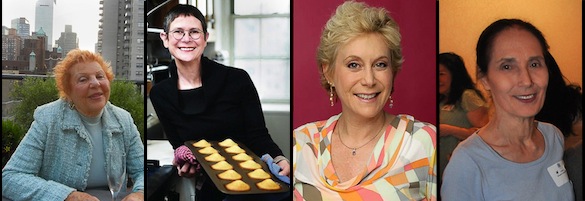
* Ladies of Les Dames d’Escoffier (L-R) Carol Brock, Dorie Greenspan, Melanie Young, Margaret Happel Perry
Julia Child moved to France in 1948 when her husband Paul was offered a position with the United States Information Service (USIS). Her fascination with French food and cooking began after experiencing that first lunch in the town of Rouen in France at La Couronne. She was so inspired by French cooking that on October 4, 1949 (at age thirty-seven) she began classes at the École du Cordon Bleu to pursue culinary studies.
Mastering the Art of French Cooking was published in 1961 after some early difficulties with the initial publisher. Nancy Barr said, “She was thrilled when it was published. What made it really special was when Judith Jones at Knopf (Alfred A. Knopf) bought the book. She (Judith) had just returned from France and understood what Julia was trying to do. Julia was trying to change the way Americans wrote recipes and followed them. She wanted people to know how to really cook and with instruction. Julia was on a mission.” Approximately a year later, in 1963, The French Chef debuted on WGBH television in Boston. Julia was affectionately bestowed the title “Our Lady of the Ladle” by Time magazine in 1966.
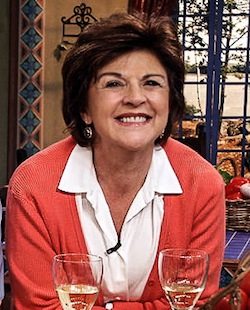
Nancy Verde Barr
In 1977, Carol Brock created Les Dames d’Escoffier to provide opportunities for women to advance in the culinary arts. Historically a male-dominated industry, LDE sought to break through this barrier with mentoring, education and networking opportunities for women. The organization also provides scholarships and is involved with philanthropic pursuits. If you are not familiar with Les Dames d’Escoffier, you may read more about the history of the group here.
Each year the organization recognizes and honors those women who have made extraordinary contributions to “the culinary, fine beverage, arts of the table or related field.” As one might expect, Julia Child was their first honoree. Carol Brock recalled, “On March 27, 1977 at the Carlyle (Hotel), the premier black tie dinner for the installation of new members to Les Dames d’Escoffier, Julia Child was made our first Grande Dame. And Jim Beard attended.”
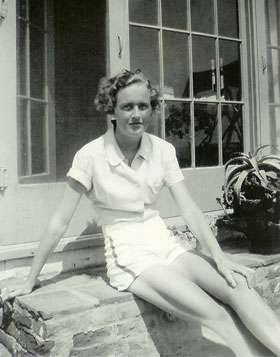
A young Julia Child – photo from the internet
Julia Child’s life was a robust one. She saw the humor in most everything. She was a great communicator, author, educator and she was a passionate lover. She was fun loving and a big flirt. Her style and grace where incomparable.
Margaret Happel Perry: “It seems as a student, Julia was from a different mold than the traditional eastern “Smithy” (Smith College). Her easy, energetic approach to life was a needed breathe of fresh air to the college in the 1930’s. This all embracing “it-can-be-done” attitude was something that carried her into the success of her TV programs and took the intimidation out of French cooking for her audience.”
That youthful can-do attitude and flirtatious style stayed with Julia her entire life.
Dorie Greenspan: “My husband Michael, our then college-aged son, Joshua, and I drove to Cambridge to take Julia to lunch right before she was to move to Santa Barbara. As we were about to leave the house, Stephanie Hersh, her long-time and wonderful assistant, pulled me aside and said, ‘You’ve got to take Julia’s walker. She hates using it, but you wouldn’t want her to fall while you’re in charge, would you?’ She said it with her signature twinkle and smile, but I knew that she was worried about Julia being wobbly. I grabbed the walker, got a quick lesson on how to fold it up and went out to present it to Julia. Too late – she was headed for the door. ‘Julia, I’ve got your walker,’ I called out. Julia linked her arm through Joshua’s, turned and said, ‘I don’t need a walker when I’ve got a handsome young man at my side.’ She leaned her head toward Joshua’s, smiled and didn’t touch the walker all afternoon. She did, however, pat my husband’s knee affectionately whenever she wanted to make a point. And even when she didn’t. Julia loved men and my men loved her back – and flirted back. ”
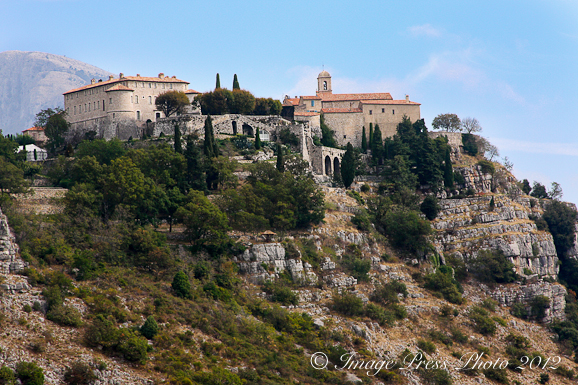
It is easy to fall in love with France. Gourdon, in the South of France, is breathtaking.
Julia always tried to see the bright side of every situation and her cheerful personality engaged all those around her and encouraged all to reach for the highest level of achievement. Carol Brock speaking of the 1977 LDEI dinner, “At that time, the Waiter’s Union was involved in lengthy, most bitter negotiations and service was less than perfect. ‘It was very nice considering it was your first dinner,’ Julia commented, even though the Maître d’ standing directly opposite the head table in full sight, kept raising his arm frantically signaling the waiters to serve!”
Nancy Verde Barr: “Julia had a humorous television personality, but she also, as she called herself, was a natural born ham. She loved to ham it up and was a cut-up. She had a very quick wit, retort and was very funny. She loved a good joke and found the humor in most anything. We would laugh so hard that tears would come to her eyes and she appreciated humor on many levels. She once conducted the Boston Pops on the Cape with a wooden spoon. Charlie Gibson (formerly of Good Morning America) was there. As hard as she worked, she played.
Julia could always take a bad situation and make it enjoyable. She was unflappable and never flustered, no matter what the situation. She knew how to run with it. One of these situations occurred on the David Letterman Show. Julia always wanted everything to be informative, no matter how simple (the dish) and she was going to show David how the make the perfect hamburger. The electric burner on the cart they wheeled on stage did not work, so she said ‘I am going to show you how to make Beef Tartare.’ In spite of David’s protests regarding eating raw meat, she told him, ‘Try it, you will like it.’ Many people would have stopped and re-taped that segment (even though it was in front of a live audience), but she just went with it.”
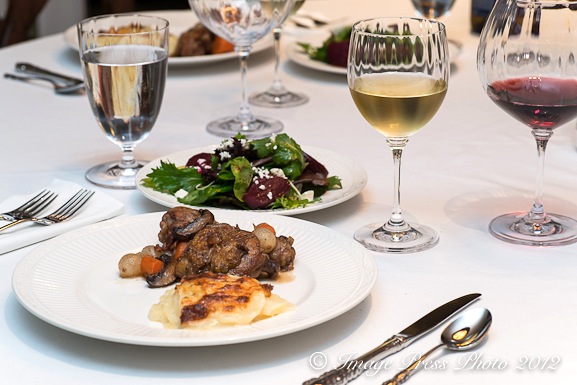
Coq au Vin and Potato Gratin. Dishes from Mastering the Art of French Cooking.
With so many gadgets filling our kitchens today, I wondered what Julia Child thought of gadgets. Nancy Barr told me, “She loved gadgets. She collected them from wherever they were stationed or wherever she visited. One of her favorites was a ricer from Germany. She loved to put the potatoes in it and say ‘woomf!’ as they were pushed through. She also had a duck press. Who else would have a duck press? If it was available, she owned it. She had all the tools of the trade and loved them. She adored her knives. She had a kit when she traveled doing demos. A large blow torch she used to brown the meringue for Baked Alaska was another one of her favorites.”
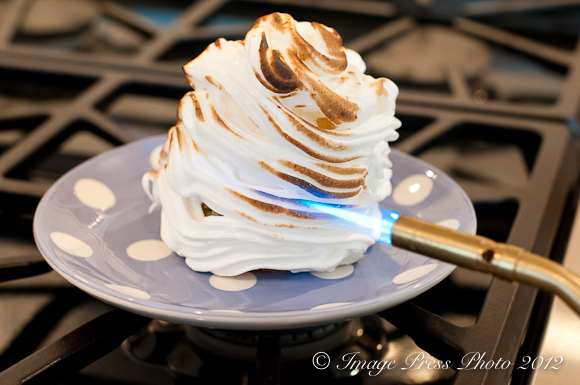
Baked Alaska. The big blow torch was one of Julia’s favorite gadgets.
Julia Child’s relationship with her husband Paul developed slowly from friends to lovers in its early stages, but it became a very passionate love affair. Julia once shared in an interview, “I would go to school in the morning, then for lunch time, I would go home and make love to my husband.”
Margaret Happel Perry: “I was food editor at Ladies Home Journal. Julia entertained a group of young married students – she loved young people – in her Cambridge home for dinner to be featured in a fall LHJ issue. This meant the meal was prepared and photographed in the first hot humid days of summer. No cooking in Julia’s kitchen. The food was prepared at the Cambridge Gas and Electric Company and taken to their house by limousine. It was there you saw the dynamics of the relationship between Paul (her husband) and Julia Child. He was her fierce protector. She was caring and deferential to him with no diminution of her irrepressible energy. From her biographies, you learn he had healed her heartbreak.”
Nancy Verde Barr: “Her relationship with Paul was beautiful, so close. They understood each other completely and loved each other until the end. It was special to watch them together. One time I went with Julia to visit Paul when he was very sick. He got up on the bed to take a nap and I felt like it was a personal moment and said I would leave. Julia said, ‘Oh no, sit with us Dearie.’ She rubbed his head and asked, ‘How’s my Paulsky?’ It was tender until the very end.”
Julia lived a long and happy life. She was 91 when she passed away in 2004, just two days before her 92nd birthday celebration where a large crowd of friends had gathered to celebrate. It has been said that it was just like Julia to have everyone arrive in town for her celebration and then decide not to attend herself.
Nancy Verde Barr: “Julia did age physically. She complained that she now had to wear shoes with straps, but did not want to. Her knees suffered from years of playing basketball. (Julia was very active in sports) However, her personality did not change. She was still fascinated with food, loved to learn new things, and was determined.
One month before she died, she had surgery and I went to see her. She was in a wheelchair, had a therapist and Julia said she would be fine. She pulled herself up out of the chair and practically went running down the walk.
When she died, it was her choice to. If she still wanted to be here, she would be.”
Margaret Happel Perry: “The last time I was with Julia Child was at a graduation for one of the first bachelor’s classes at Culinary Institute of America. Older and physically slower, there was no lack of energy and enthusiasm in her exhorting the need for achievement and high standards from the future chefs of America. She reveled in their youth, and they in her iconic words that launched them on their careers.”
Nancy Barr shared a final thought when asked what her favorite moment was with Julia. “Every one of them. I could not name just one or even twenty. Just being with her was such fun. Julia would always say, ‘Isn’t cooking together fun?’ Yes, it was. The most fun was cooking with Julia.”
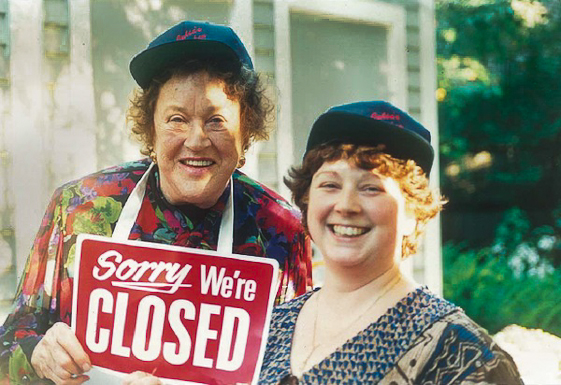
* Julia with her personal assistant Stephanie Hersh
So much has changed since Julia Child first came on the culinary scene and Les Dames d’Escoffier has played an important role in that change. I asked the current president of Les Dames d’Escoffier in New York, Melanie Young, several questions regarding the future of LDEI and the role the new media will have going forward.
Melanie Young: “New media has had a major impact on how we promote our organization and communicate with our members and with the public. Les Dames d’Escoffier has an active presence on Twitter and Facebook and we will be starting a blog to engage not only our new generation of members but also the community at-large. We find that there is a healthy interest in Les Dames d’Escoffier and we field many inquiries about how to become a member.
I think the biggest difference in our membership is the growing number of food and beverage entrepreneurs that own their own restaurants, food and beverage public relations firms, cooking schools, product lines and food equipment companies. ”
There has been a major change in culinary journalism away from traditional media outlets to digital. With the varied backgrounds, diversity and level of ability of these journalists and media, I asked if there is any effort to help influence the future of culinary journalism.
Melanie Young: “I think culinary journalism has already been influenced by social media. Look at how many print newspapers are shrinking and turning to a digital platform. The challenge is re-training people to be able to work in the digital arena. One of the programs Les Dames d’Escoffier New York started in recent years was a Professional Development Series which provides workshops on digital media for our members who may be less familiar with social media. Food blogging also helps connect Les Dames d’Escoffier to a larger community. Many of our members are bloggers, and many bloggers follow us on Facebook and Twitter.”
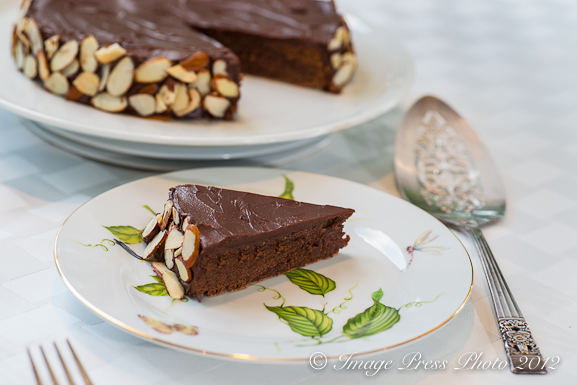
Reine de Saba (Chocolate and Almond Cake) with Glaçage au Chocolat (Chocolate-butter Icing)
Thank you so much to all of these women who took the time to share their memories of Julia for this article and to Melanie Young for her comments regarding LDEI. I also want to give a very special thank you to my good friend Ronnie Campbell (also a member of LDNY) who was instrumental in coordinating this effort.
You may be interested in this Happy 100th Julia Pinterest page that LDNY has started. Alfred A. Knopf has a Julia 100 Facebook page that is posting all things Julia.
You may also like to see this very cute and rather hip remix video of Julia. It will put a smile on your face. 🙂
I purchased the Cooking with Les Dames d’Escoffier Cookbook with the intent of making Julia’s recipe for her favorite lobster dish that has only been published in that cookbook, however, I decided a cake was more appropriate for a birthday celebration. I prepared Reine de Saba (Chocolate and Almond Cake) with Glaçage au Chocolat (Chocolate-butter Icing) from Mastering the Art of French Cooking. It was no less than spectacular with its rich dark chocolate center and mousse-like consistency and perfect for this very special occasion. When I mentioned to Nancy Barr that I had prepared this particular cake, she told me this was Julia’s favorite dessert. Happy 100th Birthday, Julia!
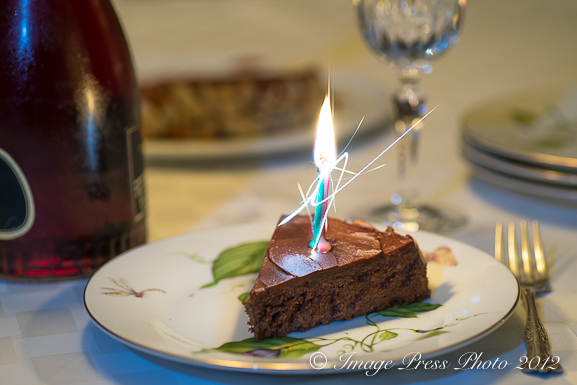
Cheers to Julia! This was Julia’s favorite dessert.
* Photograph of Julia Child at the top of the article is courtesy of Knopf Doubleday Publishing Group and the photo of Julia Child with Stephanie Hersch was used with Stephanie’s permission. Photograph of Dorie Greenspan was taken by Alan Richardson.
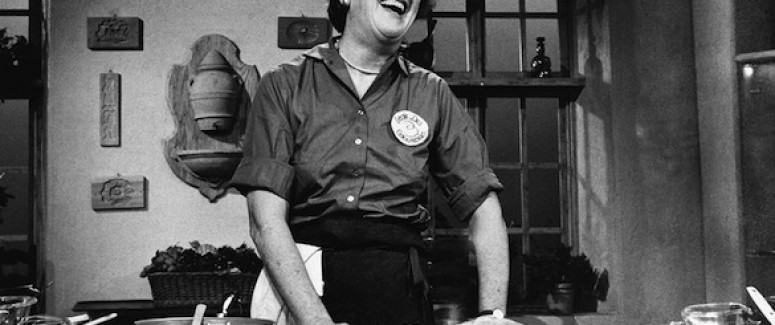
Reine de Saba (Chocolate and Almond Cake) with Chocolate-butter Icing
This extremely good chocolate cake is baked so that its center remains slightly underdone; overcooked, the cake loses its special creamy quality. It is covered with a chocolate-butter icing, and decorated with almonds. Because of its creamy center it needs no filling. It can be made by starting out with a beating of egg yolks and sugar, then proceeding with the rest of the ingredients. But because the chocolate and the almonds make a batter so stiff it is difficult to fold in the egg whites, we have chosen another method, that of creaming together the butter and sugar, and then incorporating the remaining items. – Mastering the Art of French Cooking
Ingredients:
For the cake:
4 ounces or squares semisweet chocolate melted with 2 Tablespoons rum or coffee (I used a strong coffee)
1/4 lb. or 1 stick softened butter
2/3 cup granulated sugar
3 egg yolks
3 egg whites
Pinch of salt
1 Tablespoon granulated sugar
2/3 cup pulverized almonds
1/4 tsp almond extract
For the icing:
2 ounces (2 squares) semisweet baking chocolate
2 Tb rum or coffee (I used Bank’s rum)
5 to 6 Tablespoons unsalted butter
1/2 cup cake flour (scooped and leveled) turned into a sifter
Directions:
For the cake:
1. Preheat oven to 350°F (175°C).
2. Butter and flour the cake pan. Set the chocolate and rum or coffee in a small pan, cover, and place (off heat) in a larger pan of almost simmering water; let melt while you proceed with the recipe. Measure out the rest of the ingredients. Cream the butter and sugar together for several minutes until they form a pale yellow, fluffy mixture.
3. Beat in the egg yolks until well blended.
4. Beat the egg whites and salt in a separate bowl until soft peaks are formed; sprinkle on the sugar and beat until stiff peaks are formed.
5. With a rubber spatula, blend the melted chocolate into the butter and sugar mixture, then stir in almonds, and almond extract. Immediately stir one fourth of the beaten egg whites to lighten the batter. Delicately fold in a third of the remaining whites and when partially blended, sift on one third of the flour and continue folding. Alternate rapidly with more egg whites and more flour until all egg whites and flour are incorporated.
6. Turn the batter into the cake pan, pushing the batter up to its rim with a rubber spatula. Bake in middle level of preheated oven for about 25 minutes. Cake is done when it has puffed, and 2-1/2 to 3 inches around the circumference are set so that a needle plunged into that area comes out clean; the center should move slightly if the pan is shaken, and a needle comes out oily.
7. Allow cake to cool in the pan for 10 minutes. Run knife around the edge of the pan, and reverse cake on the rack. Allow it to cool for an hour or two; it must be thoroughly cold if it is to be iced.
For the Icing:
1. Place the chocolate and rum or coffee in the small pan, cover, and set in the larger pan of almost simmering water. Remove pans from heat and let chocolate melt for 5 minutes or so, until perfectly smooth. Lift chocolate pan out of the hot water, and beat in the butter a tablespoon at a time. Then beat over the ice and water until chocolate mixture has cooled to spreading consistency. At once spread it over your cake with spatula or knife, and press a design of almonds over the icing.
Reprinted from Mastering the Art of French Cooking
Julia Child